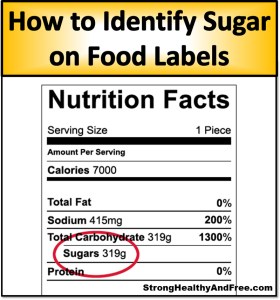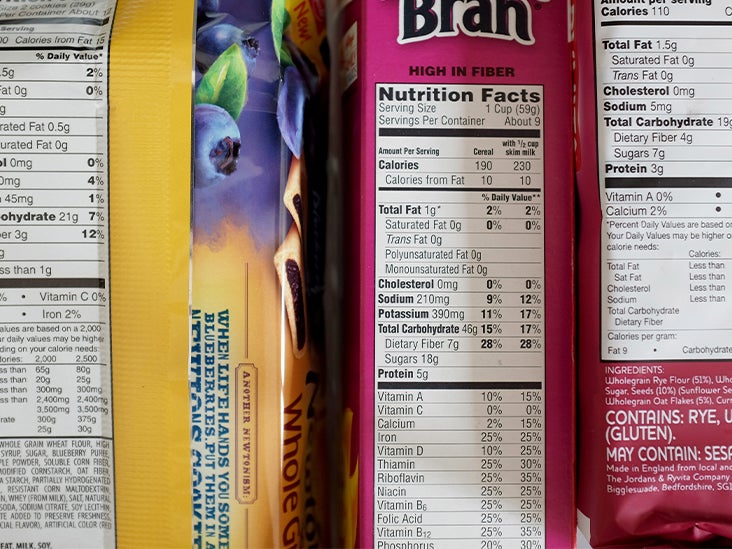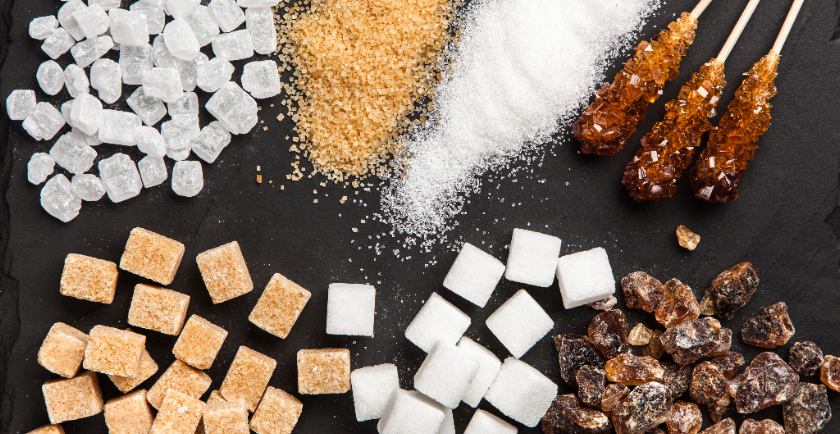42 how to read the sugar label on food labels
How to read nutrition labels | safefood Some labels use colour coding to show at a glance if a food is high, medium or low in fat, saturated fat, sugar and salt. Low (green) - the best choice. Medium (amber) - okay most of the time. High (red) - only choose occasionally. If the label isn't colour coded, use our label decoder as a guide. Reading food labels: Tips if you have diabetes - Mayo Clinic Look for foods with 3 or more grams of fiber. Put sugar-free products in their place Sugar-free doesn't mean carbohydrate-free. Sugar-free foods may play a role in your diabetes diet, but remember that it's equally important to consider carbohydrates as well. A sugar-free label means that one serving has less than 0.5 grams of sugar.
Understanding Food Labels for Better Blood Sugar Management Generally, when comparing similar food products, you should scrutinize their ingredients list and nutrition labels, then pick one that contains more of the following per 100 grams: Complex carbohydrates. Dietary fiber. Vitamins. Minerals. And you should pick one that contains less of the following per 100 grams: Calories.
How to read the sugar label on food labels
Understanding food labels - Diabetes UK Check the ingredients list - if syrup, invert syrup, cane sugar, molasses or anything ending in 'ose' is within the first three ingredients, this suggests the food contains more added sugar. Choose an alternative if possible, or be mindful of the portion you eat. Check the fibre content on the back of pack label. How To Read Food labels for Sugar | My Sugar Free Kitchen 1500 x 10% = 150 calories of added sugar per day. 150/4 = 37.5 grams of sugar. To translate 37 grams of sugar into teaspoons, divide by 4, which equals 9 teaspoons of added sugar per day max. So when you look at a nutrition label and see that is has 32grams of sugar per serve, if you divide that number by 4, it means it has 8 teaspoons of sugar . safefood | How to read food labels Some labels use colour coding to show at a glance if a food is high, medium or low in fat, saturated fat, sugar and salt. Low (green) - the best choice. Medium (amber) - okay most of the time. High (red) - only choose occasionally. If the label isn't colour coded, use our label decoder as a guide. Low (green)
How to read the sugar label on food labels. Sugars on food labels - Sugar Nutrition Resource Centre Sugars and the Nutrition Information Panel The Nutrient Information Panel on the back of the pack, shows detailed information on the average amount of energy, protein, fat, saturated fat, carbohydrate, sugars and sodium (a component of salt) in the food, as well as any other claim that requires nutrition information. How to Read Food Labels | mySugr Check the Serving Size Before reading the rest of the label, look at the serving size. The rest of the information - such as carbs, calories, sugars, fiber, and more - will be based upon the serving size that's listed. Eating more than a serving size means you'll get more carbs, sugars, and calories than what has been listed. How to Read Nutrition Labels for Sugar - hekagoodfoods Where to Find the Nutrition Label Why Added Sugar is on the New Nutrition Labels What to Look for in the Ingredients List Top Three Ingredients Sugar Listed Under Multiple Names More Fiber, Less Sugar Where to Find the Nutrition Label You'll usually find the nutrition facts label on the side or back panel of a packaged food. Food labels - NHS Colour-coded nutritional information tells you at a glance if the food has high, medium or low amounts of fat, saturated fat, sugars and salt: red means high amber means medium green means low In short, the more green on the label, the healthier the choice.
How to Read a Nutrition Label: Common Terms Found on Supplement Facts A recent revamp of nutritional labels have made it much easier to determine the source of sugar in your food. The new labels show total sugar, added sugar, and also the percent daily value of ... How to read labels for added sugar - That Sugar Movement Three: Remember that 4g = 1 teaspoon of sugar. Technically, 4.2g = 1 teaspoon of sugar, but for the easy on-the-spot calculation, just remember 4g equals one teaspoon. For example, a 375ml can of Coca-Cola is about 40g of sugar. Dividing that by 4 means there are 10 teaspoons of added sugar in the one can. As mentioned above, we want to aim for ... How to Read a Dietary Supplement Label for Diabetes When reading dietary supplement labels, look for the following information: the total carbs listed in bold letters. Total carbs are carbohydrates in grams. Both sugar and fiber are listed separately. While all carbohydrates raise blood sugar, you should use total carbs as a guide. Fiber can be found in whole-grain bread, fruits, vegetables ... PDF How to Read the Food Label - Risk Services Is your serving the same as the one on the label? • If you eat twice the serving size, you double the . calories and other nutrient values. • If you have diabetes or follow a specific meal plan, the serving size on the label may not match those in your meal plan. Always check the serving size (see sample label on page 2). Calories. This is ...
Food Labels | CDC If you eat the whole thing, you are eating 8 times the amount of calories, carbs, fat, etc., shown on the label. Total Carbohydrate shows you types of carbs in the food, including sugar and fiber. Choose foods with more fiber, vitamins, and minerals. Choose foods with lower calories, saturated fat, sodium, and added sugars. Added Sugars on the New Nutrition Facts Label | FDA Labels for foods and beverages with added sugars will list the number of grams and the percent Daily Value (%DV) for added sugars within the Nutrition Facts label. Having the word "includes" before... Are You Confused? How to Read Sugar Labels - Thin Strong Healthy You need to know. Start dividing those grams of sugar by 4 to give you the teaspoons in a serving. Then look at the serving to see what a realistic amount would be for an actually serving. Learn to read sugar labels. They think you don't know what they're doing. Now you do. Take back your health, and don't let big food win! How to Read Food Labels | mySugr Before reading the rest of the label, look at the serving size. The rest of the information — such as carbs, calories, sugars, fiber, and more — will be based on the serving size that's listed. Eating more than a serving size means you'll get more carbs, sugars, and calories than what's listed. Looking at the serving size also helps ...
How to Read the New Food Label The percent daily value (%DV) can be used as a quick guide to the food label. Try the 5/20 rule when reading a label. Think about 5% or less as low for any nutrient and 20% or more is high for any nutrient. The %DV is a great way to compare food products if the serving size is the same. Fiber is the nutrient on the label that you want to aim ...
Learning To Read Labels :: Diabetes Education Online On a nutrition food label, subtract the fiber from the total carbohydrate amount. When you read food labels, the grams of sugar are already included in the total carbohydrate amount, so you do not need to count this sugar amount separately. The grams of sugar listed include both natural sugars, from fruit or milk, and added sugars.
Understanding food labels - Action on Sugar Step 1 - Calculate amount of sugars per gram by dividing the amount of sugars per 100g OR 100ml by 100. Step 2 - Check the weight of a recommended portion as stated on the pack. Step 3 - Work out the amount of there is per portion by multiplying the figures from step 1 and 2.
How to Read a Food Label | Lamoille Health Partners At the top of the Nutrition Facts label, you will find the total number of servings in the container and the item's serving size. The serving size might be "cups" or "pieces," or some other measure. For example, peanut butter is often measured with a serving of two tablespoons. By law, serving size is based on the amount of food that ...
How To Read Food and Beverage Labels - National Institute on Aging Be on the lookout for terms that indicate added sugar, such as brown sugar, corn sweetener, corn syrup, dextrose, fructose, and high-fructose corn syrup. Artificial sweeteners such as sucralose, saccharin, aspartame, and acesulfame should also be consumed in moderation.
How to Understand and Use the Nutrition Facts Label | FDA manufacturers are encouraged, but not required, to use the "†" symbol immediately following the added sugars percent daily value on single-ingredient sugars, which would lead to a footnote...
Labeling added sugars content on packaged foods and beverages could lower heart disease/diabetes ...
Understanding Food Labels | The Nutrition Source | Harvard T.H. Chan ... Therefore, the new label shows both Total Sugar grams and Added Sugar grams. The specific types of added sweeteners will be shown in the Ingredients list. Examples: Plain dairy milk will show 12 grams of Total Sugars (naturally occurring from lactose) per cup but zero Added Sugars.
Reading Food Labels | ADA - American Diabetes Association The Nutrition Facts labels on foods are really the key to making the best choices. We'll cover the basics so that these labels make shopping easier for you. You've heard it all. From carb-free to low-carb, to whole and empty carbs, it's hard to know what it all means. Blood sugar highs and lows aren't always easy to understand.
Understanding sugar content on food labels - Diabetes Care Community On a food label, the total amount of carbohydrate in grams is listed first. This number includes starch, sugars and fibre. Fibre does not raise blood sugar levels and should be subtracted from the total carbohydrate. Say, for example, one serving of food contains 36 grams of carbohydrate, which includes 6 grams of fibre.
safefood | How to read food labels Some labels use colour coding to show at a glance if a food is high, medium or low in fat, saturated fat, sugar and salt. Low (green) - the best choice. Medium (amber) - okay most of the time. High (red) - only choose occasionally. If the label isn't colour coded, use our label decoder as a guide. Low (green)
How To Read Food labels for Sugar | My Sugar Free Kitchen 1500 x 10% = 150 calories of added sugar per day. 150/4 = 37.5 grams of sugar. To translate 37 grams of sugar into teaspoons, divide by 4, which equals 9 teaspoons of added sugar per day max. So when you look at a nutrition label and see that is has 32grams of sugar per serve, if you divide that number by 4, it means it has 8 teaspoons of sugar .
Understanding food labels - Diabetes UK Check the ingredients list - if syrup, invert syrup, cane sugar, molasses or anything ending in 'ose' is within the first three ingredients, this suggests the food contains more added sugar. Choose an alternative if possible, or be mindful of the portion you eat. Check the fibre content on the back of pack label.












Post a Comment for "42 how to read the sugar label on food labels"